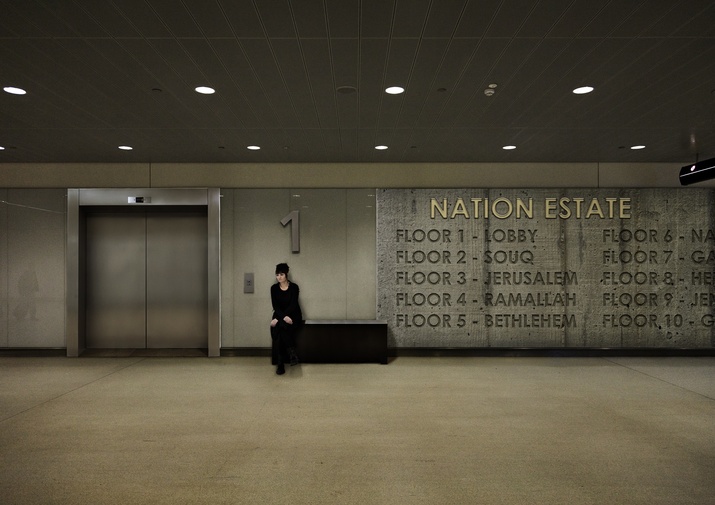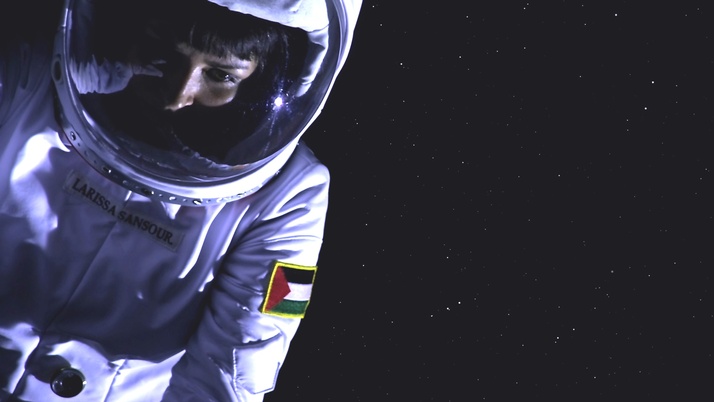
R
E
V N
E
X
T
Lacoste Elysée Prize Cancelled After Exclusion of Palestinian Artist
In late December, the 25,000 euro Lacoste Elysée Prize for photography was canceled after reports that the French clothing company had allegedly demanded the exclusion of photographer and video artist Larissa Sansour for her “pro-Palestinian” artwork, a series of three photographs entitled “Nation Estate” (2011).
Despite Lacoste and the museum having originally agreed on the selection of artists, in mid-December Sansour was asked to remove “Nation Estate” from the exhibition accompanying the prize, organized and presented by the Musée de l’Elysée, Lausanne, due to the work’s perceived political sensitivity. In an e-mail interview with ArtAsiaPacific, Sansour explained: “In addition to being eliminated from the competition, I was also asked to approve a statement saying that I had withdrawn voluntarily ‘in order to pursue other opportunities.’ Asking the censored artist to help mask the act of censorship was almost worse than having my work removed in the first place.”
Though the museum’s initial actions seemed questionable, it ultimately supported Sansour, first offering to display the work elsewhere, then deciding to cancel the 2011 edition of the prize on December 20. Immediately after the museum’s decision was announced, Lacoste withdrew its corporate backing for the award. Lacoste, which did not respond to interview requests from AAP, claimed in a statement released on its website that Sansour’s exclusion was not politically motivated, rather that “Nation Estate” did not fit the competition theme of “Joie de Vivre.” Meanwhile, in the wake of the controversy the museum proposed a solo exhibition of Sansour’s work, but as yet nothing has been confirmed.
The three photographs that comprise “Nation Estate” envision a dystopian Palestinian state. Each depicts different views inside a fictional skyscraper, located in Jerusalem, which houses the entire Palestinian population. Each floor represents an important Palestinian city, including Jerusalem (al-Quds, in Arabic) on the third floor and Ramallah on the fourth. Sansour writes about the series: “Set within a grim piece of hi-tech architecture, this narrative photo series envisions ‘la joie de vivre’ of a Palestinian state rising from the ashes of the peace process.” The digital renderings show how replicas of important monuments from each city will be displayed on each floor, including a full-scale Dome of the Rock on the Jerusalem floor. From the skyscraper’s upper floors the actual Dome of the Rock would be visible above the concrete separation wall. Sansour explained: “With Israeli settlements leaving very little land for a future Palestine, I decided to explore a vertical solution to statehood . . . Intercity trips previously marred by checkpoints are now made by elevator.”
It would surprising if Lacoste was unaware of the political nature of Sansour’s work and her sardonic humor. In the last decade, her works—accesible on her website—have been largely dedicated to the formation of a Palestinian national identity, as well as showing abuses by Israeli soldiers in the Gaza Strip and the West Bank. “For Palestinians, politics is not just one option among many, but a fundamental circumstance . . . That said, in the early years of my artistic practice, Palestine was virtually absent in my work. It was not until 2001, just after 9/11 and the second Palestinian intifada that I could no longer separate the Palestinian political context from my art,” says the artist.
Sansour often subverts Western popular culture to demonstrate the plight of her nation. “Hijacking signature Western cultural models and turning them into vehicles for ideas they were never designed to convey creates an interesting friction,” she explains. “I think, when the reality on the ground is more surreal than fiction, it is valuable to find different modes of tackling that reality rather than presenting pure documentation.”
Though she alluded to television shows such as the 1970s US sitcom Happy Days in her earlier work, Sansour has recently favored science-fiction. “Even the slickest sci-fi almost invariably carries a sense of the ‘retro,’ as ideas of the future tend to appear cliché, yet are presented as visionary. In the case of Palestine, there seems to be an eternal sense of forecasting statehood, independence and the end of the occupation. The ambitious ideas we hope to achieve have become so repetitive that the odd mix of nostalgia and self-congratulation that the sci-fi genre often embodies lends itself well to the topic.”
In her five-minute video, A Space Exodus (2009)—which will be presented in the upcoming survey of West Asian contemporary art, “Subversion,” at the Cornerhouse art space, Manchester—she reinterprets Stanley Kubrik’s cult 1968 film 2001: A Space Odyssey, playing the role of the first Palestinian astronaut in space. Toy astronauts with Palestinian flags emblazoned on their chests, made for A Space Exodus—which she dubs “Palestinauts”—have subsequently been exhibited as a separate installation work. “Even outside the original installation context people’s reaction to them is quite immediate,” Sansour says. “The combination of a toy-like innocence and unmistakable political charge seems to hit a note with audiences.”
Sansour also deals with cultural appropriation, using food as a medium. Her “Falafel Road” project, initiated in 2010 with London-based, Jerusalem-born artist Oreet Ashery, posed the question: “Where is falafel from?” Sansour believes that Israelis appropriated the deep-fried chickpea balls from Palestinian cuisine. Though her question at first seems whimsical, she notes that food is “a potent vehicle for exporting, preserving and manufacturing cultural identity.” Together, the duo visited 20 London restaurants—Israeli, Palestinian and Lebanese—in the hope of determining cultural perceptions about falafel, while simultaneously hosting a series of talks on the question. These were initially documented on a blog (falafelroad.blogspot.com) before being made into an hour-long video, Falafel Road (2010)—shown at the Istanbul nonprofit space Depo last year.
As for Sansour’s activities in 2012, she is determined to realize her vision of the “Nation Estate” series, both in digitally manipulated photographs and as a five-minute narrative film that is currently in pre-production with, she says, “elaborate special effects, futuristic folklore costumes, sci-fi food packaging and a soundtrack composed by an Iraqi musician.” She plans to complete the series in time for a solo exhibition in August at the Center of Photography in Copenhagen, Denmark.





